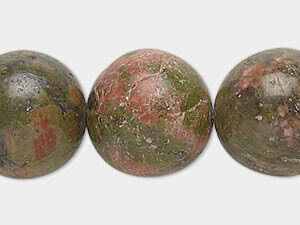Unakite Meaning and Properties
Unakite History
Unakite is a true rock: a composite material made up of multiple other stones. This gives unakite its familiar moss-on-brick appearance and makes it a popular lapidary material. The patterns, durability and affordability of unakite have also made it a useful stone for architecture--its most prominent use is trimming on the front steps of the Smithsonian Museum of Natural History in Washington, D.C.!
Unakite was first discovered in the United States, in the Unakas mountains of western North Carolina/eastern Tennessee (hence its name). However, it can also be found on the beaches of Lake Superior, where it was originally dragged by glaciers, as well as washed down from the mountains into rivers in Virginia.
What are the Metaphysical Properties of Unakite?
It is said that one common unakite meaning is how it is believed to be a stone of balance, grounding the self while bringing emotions and spirituality together. It is also said to be a stone of vision, opening the third eye and useful for scrying.
Among crystal healing practitioners, unakite is used to support convalescence from illness. One unakite meaning is that it affects the reproductive system, contributes to a healthy pregnancy and promotes the growth of skin and hair.
Unakite is associated with two chakras: to the third eye chakra for its use in vision and scrying and to the heart chakra for its ability to balance emotions. It is not a current birthstone, but it has been historically assigned to March. It is also thought to offer patience and balance to Capricorn and Scorpio.
What is Unakite Made From?
This metamorphic rock is formed when granite is altered by hydrothermal activity. Unakite—also referred to as epidote/epidotized granite--blends green epidote, pink orthoclase feldspar and clear quartz and can contain trace amounts of other materials such as magnetite or zircon. As a rock (not a gemstone or element), unakite is found only in masses, not in crystal forms.
Unakite deposits may be found in not only the United States, but also Brazil, China, Sierra Leone and South Africa.
- Mineral Information: Orthoclase feldspar, potassium aluminum silicate, epidote, calcium aluminum iron silicate hydroxide and clear quartz
- Chemical Composition: KAlSi308, Ca2(Al,Fe)3(SiO4)3(OH) and SiO2
- Color: Green with pink/salmon/terra cotta blotches and white speckles
- Hardness: 6 to 7 (Mohs)
- Specific Gravity: 2.85 - 3.20
- Refractive Index: 1.525 - 1.760
How Do You Clean Unakite?
Unakite is not a porous stone, but it can be sensitive to chemical cleaners due to its composite makeup. Avoid using ultrasonic and steam cleaning, as unakite can cleave under impact and heat can change this stone's colors. A soft cloth or brush with mild soap and warm water are ideal. Rinse off all cleaners, then pat dry with a soft cotton cloth.
Unakite FAQ
Q: What colors are typically seen in unakite?
A: Unakite is a mixed color rock, displaying green with pink/salmon/terra cotta blotches and white speckles.
Q: Where was unakite first discovered?
A: This gemstone was first discovered in the Unakas mountains of western North Carolina/eastern Tennessee in the United States.
Q: Because of the colors of unakite, should it only be used during the fall season?
A: No way! Unakite can be used in both formal and casual jewelry styles—from glossy men’s cufflinks to a knotted shamballa-style bracelet—and is great for every season.
Q: Is it easy to pair unakite beads together because they can match or is each bead's colors and patterns unique?
A: Unakite’s structure can make matching patterns extremely difficult—the variation from stone to stone is part of unakite’s beauty.
Designing Unakite Jewelry
Unakite is a great stone for men's and unisex jewelry styles. It's a colorful choice that works with a range of metals and other materials due to its mix of cool and warm hues. Unakite's multiple color tones really pop when used with black onyx or white mountain "jade." The greens can be accented by mingling with dark green aventurine while the reds can be brought to the fore by stringing with red jasper.
Unakite cleaves cleanly under impact, so it is not recommended for ring, bracelet or anklet designs.
Shop for Unakite
**Please note that all metaphysical or healing properties listed are collected from various sources. This information is offered as a service and not meant to treat medical conditions. Fire Mountain Gems and Beads® does not guarantee the validity of any of these statements.
How did you like this resource? Your feedback helps us provide resources that matter to you most.
Copyright Permissions
All works of authorship (articles, videos, tutorials and other creative works) are from the Fire Mountain Gems and Beads® Collection, and permission to copy is granted for non-commercial educational purposes only. All other reproduction requires written permission. For more information, please email copyrightpermission@firemtn.com.


